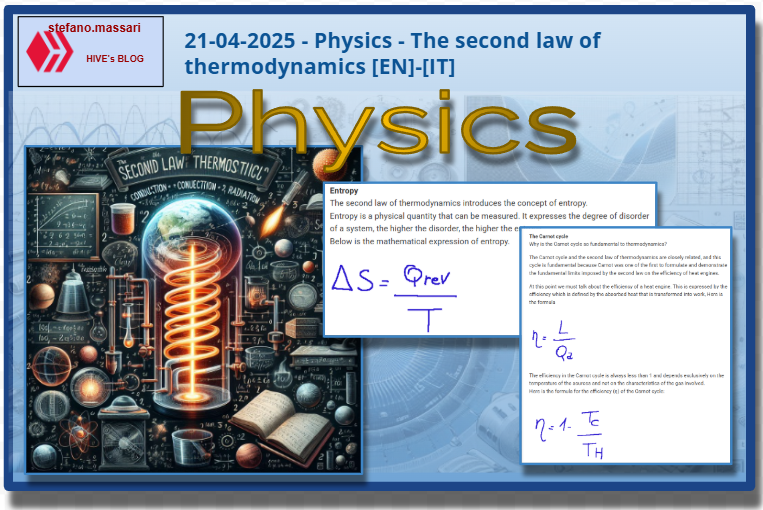
~~~ La versione in italiano inizia subito dopo la versione in inglese ~~~
ENGLISH

21-04-2025 - Physics - The second law of thermodynamics [EN]-[IT]
With this post I would like to give a brief instruction about the topic mentioned in the subject
(code notes: X_61-60-59-58)
The second law of thermodynamics
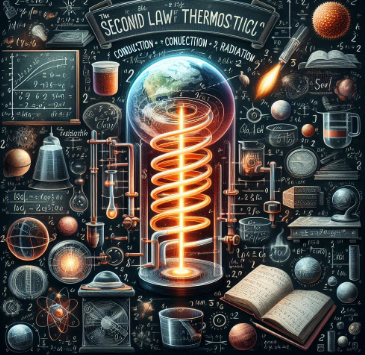
image created with artificial intelligence, the software used is Microsoft Copilot
Introduction
In this article I will try to talk a little about heat and the second law of thermodynamics.
Heat
For physics, heat is a form of energy. We can say that according to physics it is an energy that is transferred from one body to another due to a difference in temperature.
Heat propagates in three main ways: conduction, convection and radiation
We know that the passage of heat always occurs from a hotter body to a colder one. The transfer of heat, or as we said before the passage of heat, ends when the two bodies reach the same temperature.
The other thing we know is that heat is transmitted in different ways depending on whether it propagates through suns, fluids or in a vacuum. As for temperature, we can say that it is the measure of how hot or cold a body can be. We must keep in mind that temperature depends on the average state of agitation of the particles that make up the body.
From chemical studies we know that temperature essentially measures how much the particles in a body move and we know that the higher the temperature, the faster and more disordered they are.
So when the temperature decreases the particles of a body begin to move less and less. When we are close to, or in the vicinity of, absolute zero, in theory this motion stops almost completely.
At this point we can make a brief reference to the third law of thermodynamics, because in reality we have already talked about it. In fact, the third law of thermodynamics says that when a system approaches absolute zero, entropy, that is, disorder, tends to a constant minimum value. This recalls what we said before when we related the average motion of particles to temperature.
The third law of thermodynamics was conceived in 1906 by Walther Nernst, a German chemist.
Conduction, convection, radiation
Heat is transmitted in three ways: by conduction, by convection and by radiation.
Conduction
conduction is the transmission of heat by direct contact and without movement of matter. This is a particular characteristic of solid bodies. An example we can give is that of the spoon. By immersing a metal spoon in a container of boiling water, the spoon heats up.
Convection
Convection is the transmission of heat in which the movement of matter also occurs. This is a characteristic linked above all to fluids, that is, liquids such as water and gases, such as air.
Radiation
On the other hand, radiation is the transmission of heat that occurs without contact or transfer of matter. This particular heat transmission occurs through radiation. The main concept of this heat transmission is the fact that any hot body emits invisible radiation, also called infrared radiation. It is precisely infrared radiation that transports heat through space. The most classic example of heat transmission through radiation is the heat of the sun that reaches the earth.
Here is the formula for radiated power

Where:
P = radiated power (in watts, W)
σ = Stefan-Boltzmann constant
A = surface area of the body that emits radiation (in square meters, m²)
𝜀 = emissivity of the body (a value between 0 and 1, 1 is the perfect black body)
T = absolute temperature of the body (in kelvin, K)
The second law of thermodynamics
As for the second law of thermodynamics, we can already say that it is sometimes described differently, that is, there are two ways to describe this second law. In reality, the second law of thermodynamics does not have just one formulation, but rather two. These two formulations, however, even if they state different things, ultimately arrive at the same conclusion.
Kelvin-Planck formulation
The Kelvin-Planck formulation of the second law of thermodynamics states that in a thermodynamic process heat cannot be entirely converted into energy.
Clausius Formulation
The Clausius formulation of the second law of thermodynamics states that heat does not flow spontaneously from a colder body to a hotter one.
Now if we try to reread these two formulations, unless we are experts, we will have a hard time understanding that these two formulations actually express the same concept. Now let's try to explain why the second law of thermodynamics has been historically formulated in two different ways. Both formulations described above, that is, the Kelvin-Planck and the Clausius one, essentially express the irreversible nature of thermal processes found in nature.
Entropy
The second law of thermodynamics introduces the concept of entropy.
Entropy is a physical quantity that can be measured. It expresses the degree of disorder of a system, the higher the disorder, the higher the entropy.
Below is the mathematical expression of entropy.
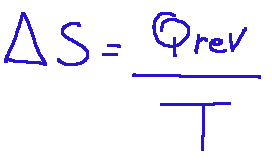
Where:
ΔS = entropy change (in J/K)
Qrev = heat absorbed or released reversibly
T = absolute temperature (in kelvin)
The Carnot cycle
Why is the Carnot cycle so fundamental to thermodynamics?
The Carnot cycle and the second law of thermodynamics are closely related, and this cycle is fundamental because Carnot was one of the first to formulate and demonstrate the fundamental limits imposed by the second law on the efficiency of heat engines.
At this point we must talk about the efficiency of a heat engine. This is expressed by the efficiency which is defined by the absorbed heat that is transformed into work, Here is the formula
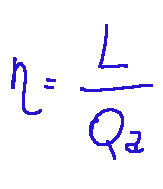
The efficiency in the Carnot cycle is always less than 1 and depends exclusively on the temperature of the sources and not on the characteristics of the gas involved.
Here is the formula for the efficiency (η) of the Carnot cycle:
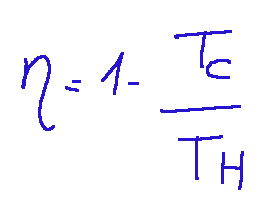
Where:
η = thermal efficiency of the cycle (number between 0 and 1, or in percentage)
TH = absolute temperature of the hot source (in Kelvin, K)
TC = absolute temperature of the cold source (in Kelvin, K)
Refrigeration machines
A refrigeration machine, also called a cooling machine, is a heat machine that produces work through the absorption of energy.
Kinetic theory of gases
The kinetic theory provides a microscopic description of the behavior of gases, while the second law imposes fundamental limits on thermodynamic processes, such as the direction of heat transfer and the efficiency of heat engines. For this reason, the kinetic theory of gases and the second law of thermodynamics are closely linked.
In this theory, it is assumed that the motion of molecules is continuous and disordered.
Temperature and kinetic energy
We have already mentioned something about this a little while ago. We can say that temperature is a measure of the average translational kinetic energy of gas molecules. There is a very precise relationship between temperature and kinetic energy, increasing the temperature increases the chaotic motion of gas particles.
Conclusions
The second law of thermodynamics is one of the fundamental principles of physics. This principle is important because it explains the direction of natural phenomena, defines the concept of entropy and imposes a limit on heat engines.
Question
Carnot laid the foundations of modern thermodynamics, and is considered the father of heat engines, but during his lifetime his publications were not considered to the point that he himself, in the last years of his life, began to doubt his theories. Carnot also died at only 36 years old, from cholera. Did you know that his work was ignored by the scientific community of the time? Did you know that Sadi Carnot was a misunderstood genius?

ITALIAN

21-04-2025 - Fisica - Il secondo principio della termodinamica [EN]-[IT]
Con questo post vorrei dare una breve istruzione a riguardo dell’argomento citato in oggetto
(code notes: X_61-60-59-58)
Il secondo principio della termodinamica

immagine creata con l’intelligenza artificiale, il software usato è Microsoft Copilot
Introduzione
In questo articolo proverò a parlare un po’ del calore e del secondo principio della termodinamica.
Il calore
Per la fisica, il calore è una forma di energia. Possiamo dire che secondo la fisica esso è un’energia che si trasferisce da un corpo all’altro a causa di una differenza di temperatura.
Il calore si propaga in tre modi principali: la conduzione, la convezione e l’irraggiamento
Il passaggio di calore sappiamo che avviene sempre da un corpo più caldo ad uno più freddo. Il trasferimento di calore, o come abbiamo detto prima il passaggio di calore, termina quando i due corpi raggiungono la stessa temperatura.
L’altra cosa che sappiamo è che il calore si trasmette in modi diversi a seconda che si propaghi attraverso soli, fluidi oppure nel vuoto.per quanto riguarda la temperatura possiamo dire che è la misura di quanto un corpo può essere caldo o freddo. Dobbiamo tenere presente che la temperatura dipende dallo stato di agitazione medio delle particelle che costituiscono il corpo.
Dagli studi chimici sappiamo che sostanzialmente la temperatura misura quanto si muovono le particelle in un corpo e sappiamo che più è alta la temperatura e più veloci e disordinate esse sono.
Quindi quando la temperatura diminuisce le particelle di un corpo iniziano a muoversi sempre meno. Quando siamo vicino, o di in prossimità, dello zero assoluto in teoria questo moto si ferma quasi completamente.
A questo punto possiamo fare un piccolo cenno al terzo principio della termodinamica, perché in realtà ne abbiamo già parlato. Infatti, il terzo principio della termodinamica dice che quando un sistema si avvicina allo zero assoluto, l’entropia, cioè il disordine, tende a un valore minimo costante. Questo richiamo quello che abbiamo detto prima quando abbiamo messo in relazione il moto medio delle particelle con la temperatura.
Il terzo principio della termodinamica lo ideò nel 1906 Walther Nernst, un chimico tedesco.
Conduzione, convezione, l’irraggiamento
Il calore si trasmette in tre modi: per conduzione, per convezione e per irraggiamento.
Conduzione
la conduzione è la trasmissione di calore per contatto diretto e senza spostamento di materia. Questa è una caratteristica particolare dei corpi solidi. Un esempio che possiamo fare è quello del cucchiaio. Immergendo un cucchiaio di metallo in una contenitore di acqua bollente, il cucchiaio si riscalda.
Convezione
La convezione è la trasmissione di calore in cui avviene anche lo spostamento di materia. Questa è una caratteristica legata soprattutto ai fluidi e cioè ai liquidi come l’acqua e ai gas, come per esempio l’aria.
Irraggiamento
L’irraggiamento invece è la trasmissione di calore che avviene senza contatto o trasferimento di materia.questa particolare trasmissione di calore avviene attraverso le radiazioni. Il concetto principale di questa trasmissione di calore è il fatto che qualsiasi corpo caldo emette radiazioni invisibili, dette anche radiazioni infrarosse. Sono proprio le radiazioni infrarosse che trasportano il calore attraverso lo spazio. L’esempio più classico della trasmissione di calore attraverso l’irraggiamento è il calore del sole che arriva sulla terra.
Qui di seguito la formula della potenza irradiata

Dove:
P = potenza irradiata (in watt, W)
σ = costante di Stefan-Boltzmann
A = superficie del corpo che emette radiazione (in metri quadrati, m²)
𝜀 = emissività del corpo (un valore tra 0 e 1, 1 è il corpo nero perfetto)
T = temperatura assoluta del corpo (in kelvin, K)
Il secondo principio della termodinamica
Per quanto riguarda il secondo principio della termodinamica, possiamo già dire che a volte viene descritto in maniera differente, cioè ci sono due modi per descrivere questo secondo principio. In realtà, il secondo principio della termodinamica non ha una formulazione solo, ma bensì sono due. Queste due formulazioni però, anche se affermano cose diverse, alla fine arrivano alla stessa medesima conclusione.
Formulazione di Kelvin-Planck
La formulazione del secondo principio della termodinamica di Kelvin-Planck stabilisce che in un processo termodinamico il calore non può essere integralmente convertito in energia.
Formulazione di Clausius
La formulazione del secondo principio della termodinamica di Clausius afferma che che il calore non fluisce spontaneamente da un corpo più freddo a uno più caldo.
Ora se provassimo a rileggere queste due formulazioni, a meno che non siamo degli esperti, faremo fatica a comprendere che queste due formulazioni in realtà esprimono lo stesso concetto. Adesso proviamo a spiegare perché il secondo principio della termodinamica è stato storicamente formulato in due modi diversi. Entrambi le formulazioni descritte prima, cioè quella di Kelvin-Planck e quella di Clausius esprimono essenzialmente il carattere irreversibile dei processi termici riscontrati in natura.
Entropia
Il secondo principio della termodinamica introduce il concetto di entropia.
L’entropia è una grandezza fisica che si può misurare. Essa esprime il grado di disordine di un sistema, più alto è il disordine e più alta è l’entropia.
Qui di seguito l’espressione matematica dell’entropia.

Dove:
ΔS = variazione di entropia (in J/K)
Qrev = calore assorbito o ceduto in modo reversibile
T = temperatura assoluta (in kelvin)
Il ciclo di Carnot
Perché il ciclo di Carnot è così fondamentale per la termodinamica?
Il ciclo di Carnot e il secondo principio della termodinamica sono strettamente legati, e questo ciclo è fondamentale perché Carnot è stato proprio uno dei primi a formulare e dimostrare i limiti fondamentali imposti dal secondo principio sull’efficienza delle macchine termiche.
A questo punto dobbiamo parlare dell’efficienza di una macchina termica. Questa viene espressa dal rendimento che è definito dal calore assorbito che viene trasformata in lavoro, Qui di seguito la formula

Il rendimento nel ciclo di Carnot è sempre minore di 1 e dipende esclusivamente dalla temperatura delle sorgenti e non dalle caratteristiche del gas coinvolto.
Qui di seguito la formula del rendimento (η) del ciclo di Carnot:

Dove:
η = rendimento termico del ciclo (numero tra 0 e 1, oppure in percentuale)
TH = temperatura assoluta della sorgente calda (in Kelvin, K)
TC = temperatura assoluta della sorgente fredda (in Kelvin, K)
Macchine frigorifere
Una macchina frigorifera, detta anche macchina refrigerante, è una macchina termica che produce il lavoro tramite un assorbimento di energia.
Teoria cinetica dei gas
La teoria cinetica fornisce una descrizione microscopica del comportamento dei gas, mentre il secondo principio impone limiti fondamentali ai processi termodinamici, come la direzione del trasferimento di calore e l'efficienza delle macchine termiche. Per questo motivo la teoria cinetica dei gas e il secondo principio della termodinamica sono strettamente collegati.
In questa teoria si suppone che il moto delle molecole è continuo e disordinato.
Temperatura ed energia cinetica
Su questo abbiamo già accennato qualcosa poco fa. Possiamo dire che la temperatura è una misura dell’energia cinetica traslazionale media delle molecole del gas. C’è una relazione molto precisa tra la temperatura e l’energia cinetica, aumentando la temperatura aumenta il moto caotico delle particelle del gas.
Conclusioni
Il secondo principio della termodinamica è uno dei principi fondamentali della fisica Questo principio è importante perché spiega la direzione dei fenomeni naturali, definisce il concetto di entropia e impone un limite alle macchine termiche.
Domanda
Carnot gettò le basi della termodinamica moderna, ed è considerato padre delle macchine termiche, ma in vita le sue pubblicazioni non vennero considerate fino addirittura a far sì che lui stesso, negli ultimi anni di vita, inizio a dubitare delle sue terorie. Carnot inoltre morì a soli 36 anni, per il colera. Lo sapevate che il suo lavoro fu ignorato dalla comunità scientifica del tempo? Lo sapevate che Sadi Carnot fu un genio incompreso?
THE END